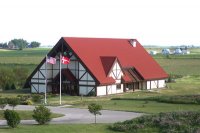Danish Museum offers new exhibit exploring the history of Schleswig-Holstein on the border between Denmark and Germany
February 24th, 2014 by Ric Hanson
Officials with The Museum of Danish America in Elk Horn have announced an upcoming exhibition exploring the history of Schleswig-Holstein on the border between Denmark and Germany.
For centuries, the duchies of Schleswig and Holstein (in Danish, Slesvig and Holsten) have been a bridge between Scandinavia and continental Europe. Located on the southern portion of the Jutland peninsula, the region is home to Danish, German, and Frisian peoples.
Over time, Schleswig-Holstein became an emblem for power struggles between larger European nations, and differing ideas of nationalism influenced the Jutland peninsula. Events in that small corner of the world have re-shaped the boundaries between nations and inspired waves of immigrants to the United States.
The two Schleswig wars, in 1848 and in 1864, had lasting impacts on immigration to the United States. A wave of revolutionary movements swept across Europe in 1848, including the German states and surrounding regions. The professional teachers, journalists, and lawyers who settled in the U.S. are often called the “48ers”, as they brought their political ideals to their new country and many continued to advocate for liberal values.
By 1890, over half of the immigrants from Schleswig – approximately 19,000 people living in the United States at the time – were living in Iowa. Their legacy is seen in the Iowa towns named “Schleswig,” Holstein”, and “Schley”, all settled by German immigrants, as well as Fredsville (“peace-ville”) settled by Danes. Within the Danish immigrant communities of Elk Horn, Kimballton, Exira, and neighboring towns, many Danish-American residents trace their ancestry to Danish immigrants from Schleswig.
“Schleswig-Holstein: Turmoil on the Danish-German Border” is supported by a grant from Humanities Iowa and the National Endowment for the Humanities. Additional support for the traveling version of this exhibit is provided by the Albert V. Ravenholt Fund and the Danish Sisterhood Lodge #15 (Wisconsin). For more information, visit www.danishmueseum.org.






